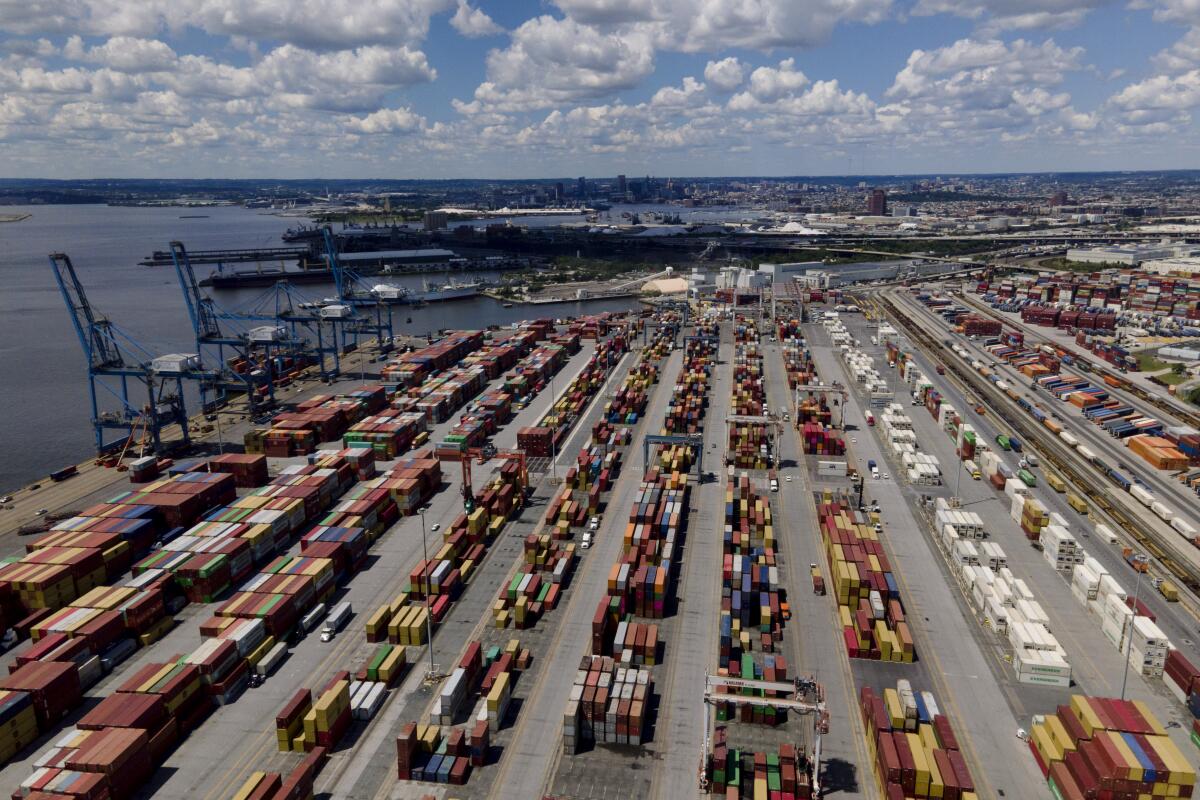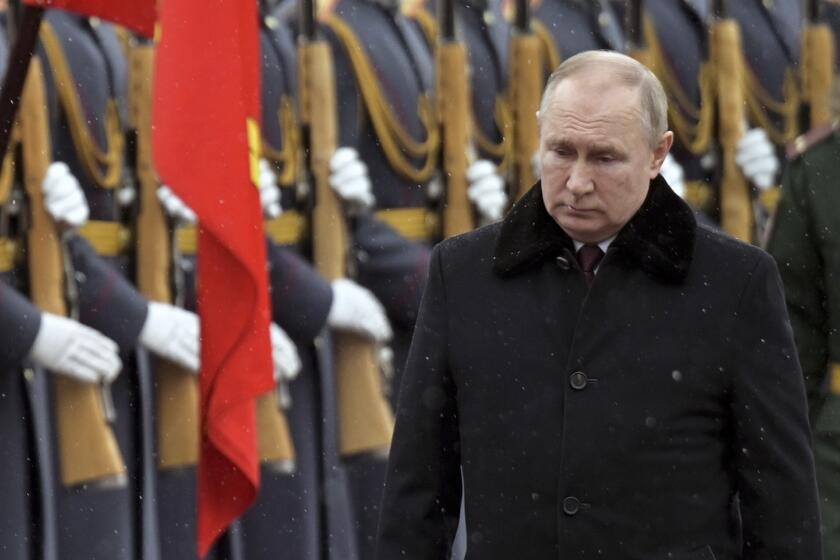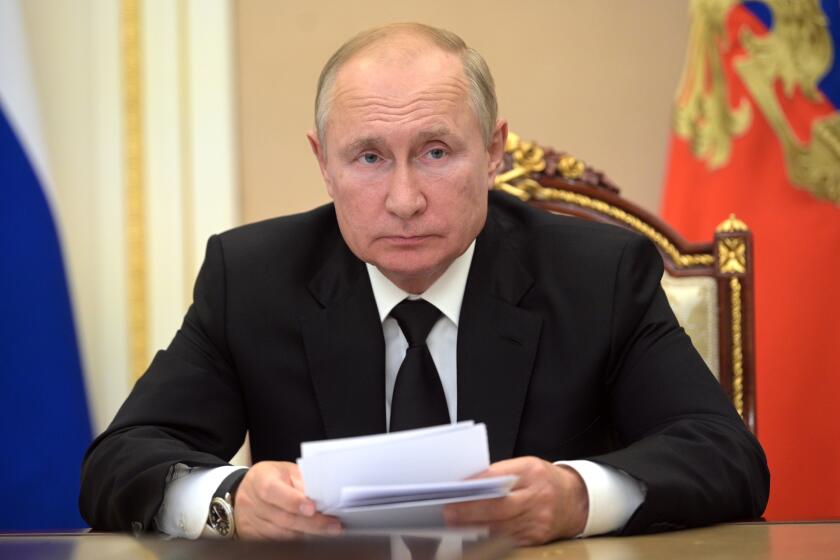Wood flooring, pillows, shoes: Despite Ukraine war, Russian goods still flow to the U.S.

- Share via
BALTIMORE — On a hot, humid day this summer, a container ship pulled into the Port of Baltimore loaded with sheets of plywood, aluminum rods and radioactive material — all sourced from the fields, forests and factories of Russia.
President Biden promised to “inflict pain” on and deal “a crushing blow” to Russia through trade restrictions on commodities such as vodka, diamonds and gasoline in the wake of Moscow’s invasion of Ukraine six months ago. But hundreds of other types of unsanctioned goods worth billions of dollars, including those found on the ship bound for Baltimore from St. Petersburg, Russia, continue to flow into U.S. ports.
The Associated Press found that more than 3,600 shipments of wood, metals, rubber and other goods have arrived at U.S. ports from Russia since Russian forces rolled into Ukraine in late February. That’s a significant drop from the same period in 2021, when about 6,000 shipments arrived, but it still adds up to more than $1 billion worth of commerce a month.
In reality, no one involved expected trade to drag to a halt after the invasion. Banning imports of certain items would probably do more harm to those sectors in the U.S. than in Russia.
“When we impose sanctions, it could disrupt global trade. So our job is to think about which sanctions deliver the most impact while also allowing global trade to work,” Ambassador Jim O’Brien, who heads the State Department’s Office of Sanctions Coordination, told the Associated Press.
Experts say the global economy is so intertwined that sanctions must be limited in scope to avoid driving up prices in an already unstable market.
Record foreign currency reserves, low debt and digital currencies have given Russia room to maneuver despite sanctions. But will China lend a hand?
Also, U.S. sanctions don’t exist in a vacuum. Layers of European Union and British bans result in convoluted trade rules that can be confusing to buyers, sellers and policymakers.
For example, the Biden administration and the EU released separate lists of Russian companies that are off-limits for trade, but at least one of those companies — which supplies the Russian military with metal to make fighter jets dropping bombs in Ukraine — is still selling millions of dollars’ worth of metal to American and European firms, the AP found.
While some U.S. importers are sourcing alternative materials elsewhere, others say they have no choice.
In the case of wood imports, Russia’s dense birch forests create such hard, strong timber that most American wooden classroom furniture, and much home flooring, is made from it. Shipping containers of Russian items — groats, weightlifting shoes, crypto-mining gear, even pillows — arrive at U.S. ports almost every day.
A breakdown of imported goods from Russia shows some items are clearly legal and even encouraged by the Biden administration, such as the more than 100 shipments of fertilizer that have arrived since the invasion. Now-banned products including Russian oil and gas continued to arrive in U.S. ports long after the announcement of sanctions because of “wind-down” periods, allowing companies to fulfill terms of existing contracts.
These companies are staying the course in Russia, to their discredit.
In some cases, the origin of products shipped out of Russian ports can be difficult to discern. U.S. energy companies are continuing to import oil from Kazakhstan through Russian ports, even though that oil is sometimes mixed with Russian fuel. Trade experts warn that Russian suppliers are unreliable, and opaque corporate structures of most major Russian companies make it difficult to determine whether they have ties to the government.
“It is a general rule: When you have sanctions, you’ll have all kinds of murky schemes and illicit trade,” said Russian economist Konstantin Sonin, who teaches at the University of Chicago. “Still, sanctions make sense because even though you cannot kill 100% of revenues, you can reduce them.”
Many American companies are choosing to cut off Russian trade. Coors beer, for example, returned a shipment of hops to a state-owned Russian company in May as part of a commitment to suspend all business in the country, said Molson Coors Beverage Co. spokeswoman Jennifer Martinez.
Russia and the U.S. were never major trading partners, and so sanctioning imports is only a very small slice of the retaliatory strategy. Restrictions on exports to Russia from the U.S. — of technology in particular — cause more damage to the Russian economy, and sanctioning the Russian Central Bank has frozen Russia’s access to roughly $600 billion in currency reserves held across the U.S. and Europe.
Nonetheless, sanctions carry a symbolic weight beyond the financial harm they might inflict, particularly for American consumers horrified by the war.
More to Read
Sign up for Essential California
The most important California stories and recommendations in your inbox every morning.
You may occasionally receive promotional content from the Los Angeles Times.












